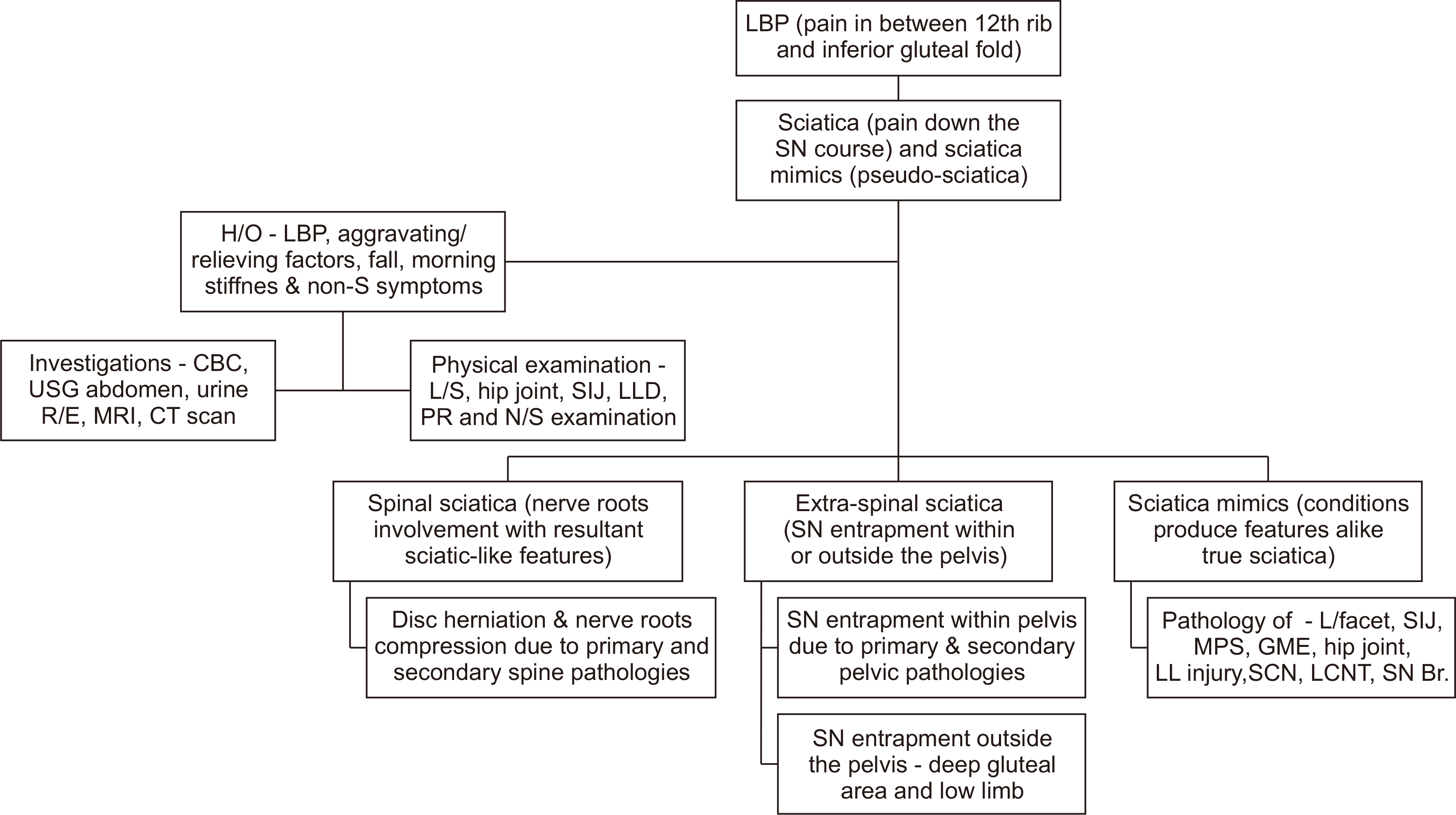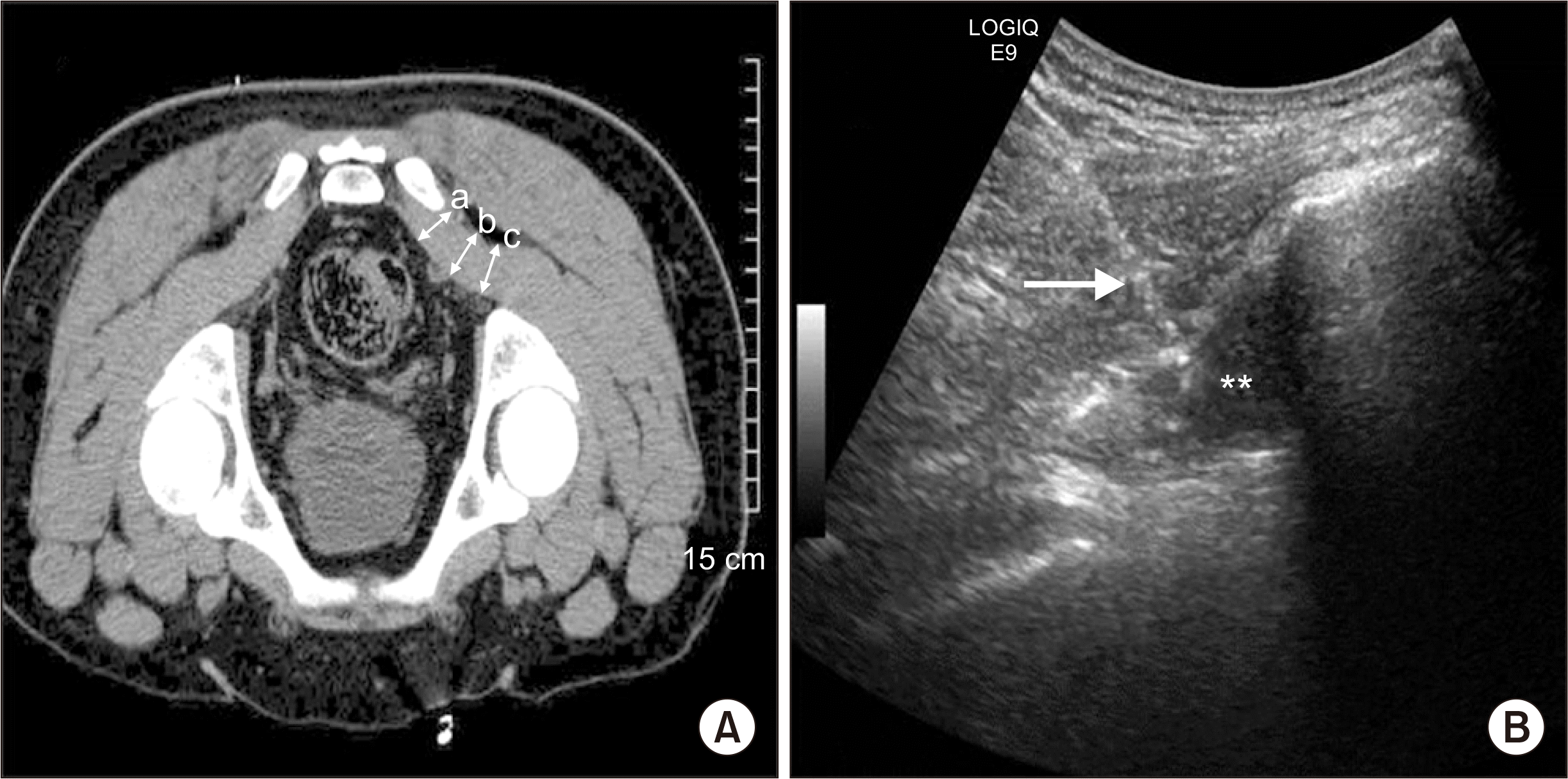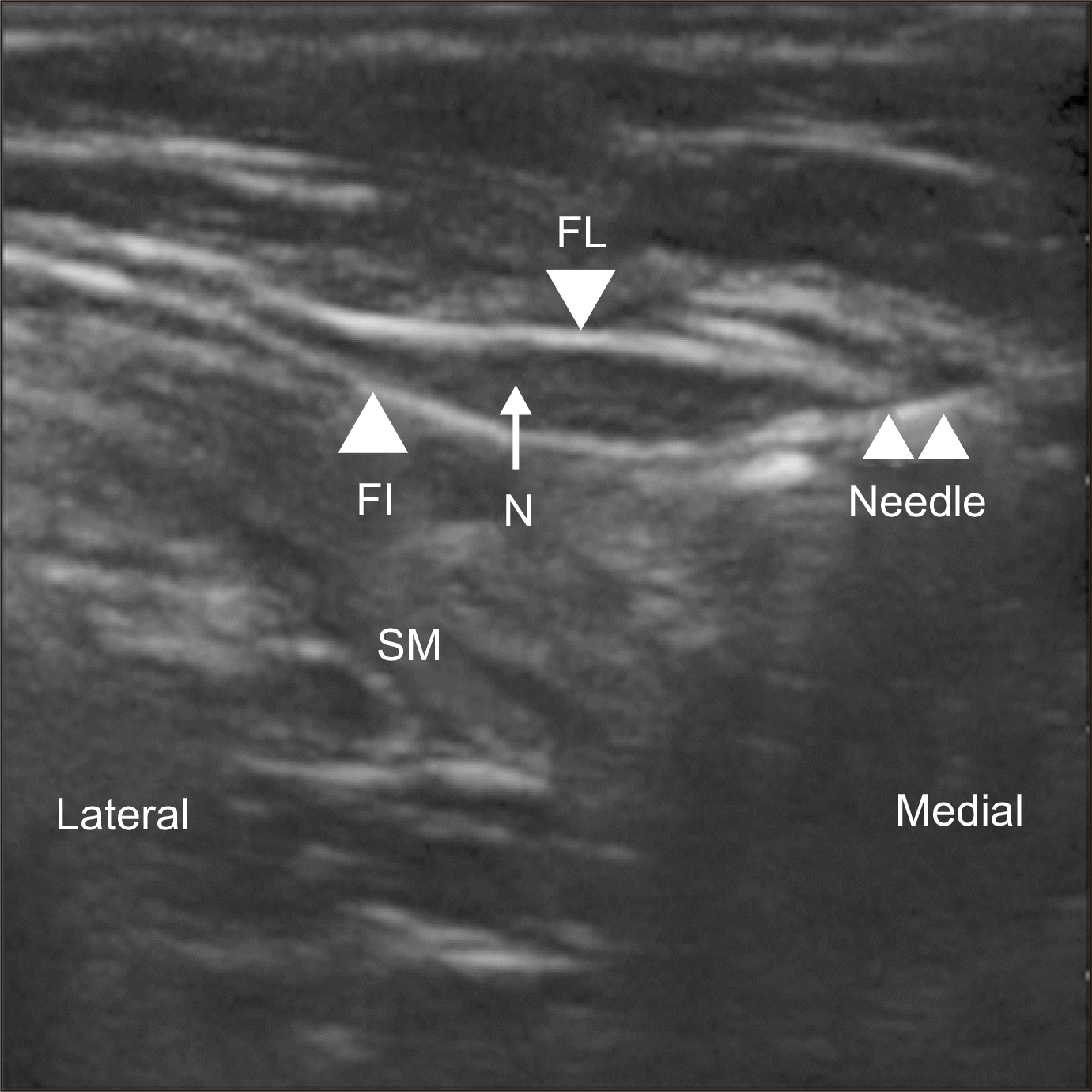1. Stafford MA, Peng P, Hill DA. 2007; Sciatica: a review of history, epidemiology, pathogenesis, and the role of epidural steroid injection in management. Br J Anaesth. 99:461–73. DOI:
10.1093/bja/aem238. PMID:
17704089.

2. Mixter WJ, Barr JS. 1934; Rupture of the intervertebral disc with involvement of the spinal canal. N Engl J Med. 211:210–15. DOI:
10.1056/NEJM193408022110506.

3. Konstantinou K, Dunn KM, Ogollah R, Vogel S, Hay EM. ATLAS study research team. 2015; Characteristics of patients with low back and leg pain seeking treatment in primary care: baseline results from the ATLAS cohort study. BMC Musculoskelet Disord. 16:332. DOI:
10.1186/s12891-015-0787-8. PMID:
26537894. PMCID:
PMC4634730.

4. Ailianou A, Fitsiori A, Syrogiannopoulou A, Toso S, Viallon M, Merlini L, et al. 2012; Review of the principal extra spinal pathologies causing sciatica and new MRI approaches. Br J Radiol. 85:672–81. DOI:
10.1259/bjr/84443179. PMID:
22374280. PMCID:
PMC3474092.

6. Buijs E, Visser L, Groen G. 2007; Sciatica and the sacroiliac joint: a forgotten concept. Br J Anaesth. 99:713–6. DOI:
10.1093/bja/aem257. PMID:
17872935.

7. Siddiq MA, Hossain MS, Uddin MM, Jahan I, Khasru MR, Haider NM, et al. 2017; Piriformis syndrome: a case series of 31 Bangladeshi people with literature review. Eur J Orthop Surg Traumatol. 27:193–203. DOI:
10.1007/s00590-016-1853-0. PMID:
27644428.

8. Atıcı A, Geler Külcü D, Akpınar P, Akay Urgun D. 2017; A rare cause of non-discogenic sciatica; musculus gemellus inferior: a case report. Turk J Phys Med Rehabil. 63:355–6. DOI:
10.5606/tftrd.2017.684. PMID:
31453480. PMCID:
PMC6648076.

9. Shete KM, Pandve HT, Joshi T. 2017; Adductor magnus tear a rare cause of sciatica: a case report. EC Orthop. 7:197–201.
10. Panagiotopoulos EC, Syggelos SA, Plotas A, Tsigkas G, Dimopoulos P. 2008; Sciatica due to extrapelvic heterotopic ossification: a case report. J Med Case Rep. 2:298. DOI:
10.1186/1752-1947-2-298. PMID:
18783597. PMCID:
PMC2556682.

11. Hansen JM, Rasti Z, Smith T, Lassen LH. 2010; Sciatic neuropathy as first sign of metastasising prostate cancer. BMJ Case Rep. 2010:bcr1220092529. DOI:
10.1136/bcr.12.2009.2529.

16. Hopayian K, Song F, Riera R, Sambandan S. 2010; The clinical features of the piriformis syndrome: a systematic review. Eur Spine J. 19:2095–109. DOI:
10.1007/s00586-010-1504-9. PMID:
20596735. PMCID:
PMC2997212.

18. Siddiq AB, Rasker JJ. 2018; Piriformis syndrome: still unsolved issues. Int J Clin Rheumtol. 13:338–40. DOI:
10.4172/1758-4272.1000207.
19. Boyajian-O'Neill LA, McClain RL, Coleman MK, Thomas PP. 2008; Diagnosis and management of piriformis syndrome: an osteopathic approach. J Am Osteopath Assoc. 108:657–64. DOI:
10.7556/jaoa.2008.108.11.657. PMID:
19011229.
20. Siddiq MA, Khasru MR, Rasker JJ. 2014; Piriformis syndrome in fibromyalgia: clinical diagnosis and successful treatment. Case Rep Rheumatol. 2014:893836. DOI:
10.1155/2014/893836. PMID:
25328750. PMCID:
PMC4190119.

21. Park CH, Lee SH, Lee SC, Park HS. 2011; Piriformis muscle: clinical anatomy with computed tomography in Korean population. Korean J Pain. 24:87–92. DOI:
10.3344/kjp.2011.24.2.87. PMID:
21716616. PMCID:
PMC3111565.

22. Fishman LM, Dombi GW, Michaelsen C, Ringel S, Rozbruch J, Rosner B, et al. 2002; Piriformis syndrome: diagnosis, treatment, and outcome--a 10-year study. Arch Phys Med Rehabil. 83:295–301. DOI:
10.1053/apmr.2002.30622. PMID:
11887107.

23. Jeong HS, Lee GY, Lee EG, Joe EG, Lee JW, Kang HS. 2015; Long-term assessment of clinical outcomes of ultrasound-guided steroid injections in patients with piriformis syndrome. Ultrasonography. 34:206–10. DOI:
10.14366/usg.14039. PMID:
25672769. PMCID:
PMC4484286.

24. Al-Al-Shaikh M, Michel F, Parratte B, Kastler B, Vidal C, Aubry S. 2015; Évaluation en IRM des modifications morphologiques du muscle piriforme chez les patients traités par toxine botulinique pour syndrome du canal infra-piriforme. J Radiol Diagn Interv. 96(Suppl 2):S99–105. French. DOI:
10.1016/j.jradio.2014.01.011.

28. Bosma JW, Wijntjes J, Hilgevoord TA, Veenstra J. 2014; Severe isolated sciatic neuropathy due to a modified lotus position. World J Clin Cases. 2:39–41. DOI:
10.12998/wjcc.v2.i2.39. PMID:
24579070. PMCID:
PMC3936218.

29. Kim D, Kwon OY, Kim Y, Hye KS, Son S, Park KJ, et al. 2004; A case of bilateral sciatic neuropathy caused by lotus position. J Korean Neurol Assoc. 22:418–20.
30. Siddiq MAB, Rasker JJ. 2019; Piriformis pyomyositis, a cause of piriformis syndrome-a systematic search and review. Clin Rheumatol. 38:1811–21. DOI:
10.1007/s10067-019-04552-y. PMID:
31049761.

32. Brosens I, Benagiano G. 2011; Endometriosis, a modern syndrome. Indian J Med Res. 133:581–93. PMID:
21727656. PMCID:
PMC3135985.
33. Steinberg JA, Gonda DD, Muller K, Ciacci JD. 2014; Endometriosis of the conus medullaris causing cyclic radiculopathy. J Neurosurg Spine. 21:799–804. DOI:
10.3171/2014.7.SPINE14117. PMID:
25192376.

34. Chamié LP, Ribeiro DMFR, Tiferes DA, Macedo Neto AC, Serafini PC. 2018; Atypical sites of deeply infiltrative endometriosis: clinical characteristics and imaging findings. Radiographics. 38:309–28. DOI:
10.1148/rg.2018170093. PMID:
29320327.

35. Vercellini P, Chapron C, Fedele L, Frontino G, Zaina B, Crosignani PG. 2003; Evidence for asymmetric distribution of sciatic nerve endometriosis. Obstet Gynecol. 102:383–7. DOI:
10.1097/00006250-200308000-00029. PMID:
12907116.

36. Dhôte R, Tudoret L, Bachmeyer C, Legmann P, Christoforov B. 1996; Cyclic sciatica. A manifestation of compression of the sciatic nerve by endometriosis. A case report. Spine. 21:2277–9. DOI:
10.1097/00007632-199610010-00021. PMID:
8902975.

37. Possover M, Chiantera V. 2007; Isolated infiltrative endometriosis of the sciatic nerve: a report of three patients. Fertil Steril. 87:417.e17–9. DOI:
10.1016/j.fertnstert.2006.05.084. PMID:
17276152.

38. Siquara De Sousa AC, Capek S, Amrami KK, Spinner RJ. 2015; Neural involvement in endometriosis: review of anatomic distribution and mechanisms. Clin Anat. 28:1029–38. DOI:
10.1002/ca.22617. PMID:
26296428.

39. Mannan K, Altaf F, Maniar S, Tirabosco R, Sinisi M, Carlstedt T. 2008; Cyclical sciatica: endometriosis of the sciatic nerve. J Bone Joint Surg Br. 90:98–101. DOI:
10.1302/0301-620X.90B1.19832. PMID:
18160509.
40. Floyd JR 2nd, Keeler ER, Euscher ED, McCutcheon IE. 2011; Cyclic sciatica from extrapelvic endometriosis affecting the sciatic nerve. J Neurosurg Spine. 14:281–9. DOI:
10.3171/2010.10.SPINE09162. PMID:
21184633.

42. Kim HR, Kim YB, Kim DL, Kim SK, Lee SH. 2006; A case of osteitis condensans ilii in a nulliparous woman. J Korean Rheum Assoc. 13:226–9.
45. Olivieri I, Gemignani G, Camerini E, Semeria R, Christou C, Giustarini S, et al. 1990; Differential diagnosis between osteitis condensans ilii and sacroiliitis. J Rheumatol. 17:1504–12. PMID:
1757952.
47. Biswas S, Konala VM, Adapa S, Amudala P, Naramala S. 2019; Osteitis condensans ilii: an uncommon cause of back pain. Cureus. 11:e4518. DOI:
10.7759/cureus.4518. PMID:
31259127. PMCID:
PMC6590857.

48. Szabados MC. 1947; Osteitis condensans ilit; report of three cases associated with urinary infection. J Fla Med Assoc. 34:95–9. PMID:
20253972.
50. Parperis K, Psarelis S, Nikiphorou E. 2020; Osteitis condensans ilii: current knowledge and diagnostic approach. Rheumatol Int. 40:1013–9. DOI:
10.1007/s00296-020-04582-9. PMID:
32328707.

52. van der Heijde D, Deodhar A, Wei JC, Drescher E, Fleishaker D, Hendrikx T, et al. 2017; Tofacitinib in patients with ankylosing spondylitis: a phase II, 16-week, randomised, placebo-controlled, dose-ranging study. Ann Rheum Dis. 76:1340–7. DOI:
10.1136/annrheumdis-2016-210322. PMID:
28130206. PMCID:
PMC5738601.

54. Kuniya H, Aota Y, Saito T, Kamiya Y, Funakoshi K, Terayama H, et al. 2013; Anatomical study of superior cluneal nerve entrapment. J Neurosurg Spine. 19:76–80. DOI:
10.3171/2013.4.SPINE12683. PMID:
23641672.

55. Maigne JY, Maigne R. 1991; Trigger point of the posterior iliac crest: painful iliolumbar ligament insertion or cutaneous dorsal ramus pain? An anatomic study. Arch Phys Med Rehabil. 72:734–7. PMID:
1834038.
56. Morimoto D, Isu T, Kim K, Imai T, Yamazaki K, Matsumoto R, et al. 2013; Surgical treatment of superior cluneal nerve entrapment neuropathy. J Neurosurg Spine. 19:71–5. DOI:
10.3171/2013.3.SPINE12420. PMID:
23621641.

57. Chang KV, Lin CP, Lin CS, Wu WT, Karmakar MK, Özçakar L. 2017; Sonographic tracking of trunk nerves: essential for ultrasound-guided pain management and research. J Pain Res. 10:79–88. DOI:
10.2147/JPR.S123828. PMID:
28115867. PMCID:
PMC5222601.

58. Wan Q, Lin C, Li X, Zeng W, Ma C. 2015; MRI assessment of paraspinal muscles in patients with acute and chronic unilateral low back pain. Br J Radiol. 88:20140546. DOI:
10.1259/bjr.20140546. PMID:
26105517. PMCID:
PMC4743557.

59. Iglesias-González JJ, Muñoz-García MT, Rodrigues-de-Souza DP, Alburquerque-Sendín F, Fernández-de-Las-Peñas C. 2013; Myofascial trigger points, pain, disability, and sleep quality in patients with chronic nonspecific low back pain. Pain Med. 14:1964–70. DOI:
10.1111/pme.12224. PMID:
23947760.

60. Kamaz M, Kireşi D, Oğuz H, Emlik D, Levendoğlu F. 2007; CT measurement of trunk muscle areas in patients with chronic low back pain. Diagn Interv Radiol. 13:144–8. PMID:
17846989.
61. Hides J, Stanton W, Freke M, Wilson S, McMahon S, Richardson C. 2009; MRI study of the size, symmetry and function of the trunk muscles among elite cricketers with and without low back pain. Br J Sports Med. 43:310–1. DOI:
10.1136/bjsm.2007.044024. PMID:
18065440.

62. Almedghio S, Garneti N. 2014; The acute and chronic presentation of gluteus medius calcific tendinitis- a case report of two. J Orthop Case Rep. 4:48–50. DOI:
10.13107/jocr.2250-0685.225. PMID:
27299002. PMCID:
PMC4719271.
63. Grimaldi A, Mellor R, Hodges P, Bennell K, Wajswelner H, Vicenzino B. 2015; Gluteal tendinopathy: a review of mechanisms, assessment and management. Sports Med. 45:1107–19. DOI:
10.1007/s40279-015-0336-5. PMID:
25969366.

64. Lee JJ, Harrison JR, Boachie-Adjei K, Vargas E, Moley PJ. 2016; Platelet-rich plasma injections with needle tenotomy for gluteus medius tendinopathy: a registry study with prospective follow-up. Orthop J Sports Med. 4:2325967116671692. DOI:
10.1177/2325967116671692. PMID:
27868077. PMCID:
PMC5105294.
65. Fitzpatrick J, Bulsara MK, O'Donnell J, McCrory PR, Zheng MH. 2018; The effectiveness of platelet-rich plasma injections in gluteal tendinopathy: a randomized, double-blind controlled trial comparing a single platelet-rich plasma injection with a single corticosteroid injection. Am J Sports Med. 46:933–9. DOI:
10.1177/0363546517745525. PMID:
29293361.

67. Gentili F, Hudson AR, Hunter D. 1980; Clinical and experimental aspects of injection injuries of peripheral nerves. Can J Neurol Sci. 7:143–51. DOI:
10.1017/S0317167100023520. PMID:
7407720. PMCID:
PMC5363928.

69. Geyik S, Geyik M, Yigiter R, Kuzudisli S, Saglam S, Elci MA, et al. 2017; Preventing sciatic nerve injury due to intramuscular injection: ten-year single-center experience and literature review. Turk Neurosurg. 27:636–40. DOI:
10.5137/1019-5149.JTN.16956-16.1. PMID:
27593812.
70. Yaffe B, Pri-Chen S, Lin E, Engel J, Modan M. 1986; Peripheral nerve injection injury: an experimental pilot study of treatment modalities. J Reconstr Microsurg. 3:33–7. DOI:
10.1055/s-2007-1007036. PMID:
3795194.

71. Villarejo FJ, Pascual AM. 1993; Injection injury of the sciatic nerve (370 cases). Childs Nerv Syst. 9:229–32. DOI:
10.1007/BF00303575. PMID:
8402705.

72. Fatunde OJ, Familusi JB. 2001; Injection-induced sciatic nerve injury in Nigerian children. Cent Afr J Med. 47:35–8. DOI:
10.4314/cajm.v47i2.8590. PMID:
11957269.
73. Mayer M, Romain O. 2001; [Sciatic paralysis after a buttock intramuscular injection in children: an ongoing risk factor]. Arch Pediatr. 8:321–3. French. PMID:
11270260.
74. Sobel E, Huang EY, Wieting CB. 1997; Drop foot as a complication of acupuncture injury and intragluteal injection. J Am Podiatr Med Assoc. 87:52–9. DOI:
10.7547/87507315-87-2-52. PMID:
9046749.

75. Napiontek M, Ruszkowski K. 1993; Paralytic drop foot and gluteal fibrosis after intramuscular injections. J Bone Joint Surg Br. 75:83–5. DOI:
10.1302/0301-620X.75B1.8421043. PMID:
8421043.

77. Huang Y, Yan Q, Lei W. 2000; [Gluteal sciatic nerve injury and its treatment]. Zhongguo Xiu Fu Chong Jian Wai Ke Za Zhi. 14:83–6. Chinese.
79. Rhanim A, El Zanati R, Mahfoud M, Berrada MS, El Yaacoubi M. 2013; A rare cause of chronic sciatic pain: schwannoma of the sciatic nerve. J Clin Orthop Trauma. 4:89–92. DOI:
10.1016/j.jcot.2013.04.001. PMID:
26403631. PMCID:
PMC3880523.

81. Sintzoff SA Jr, Bank WO, Gevenois PA, Matos C, Noterman J, Flament-Durand J, et al. 1992; Simultaneous neurofibroma and schwannoma of the sciatic nerve. AJNR Am J Neuroradiol. 13:1249–52. DOI:
10.1016/j.ijporl.2019.01.021. PMID:
1636545.
82. Watanabe T, Oda Y, Tamiya S, Masuda K, Tsuneyoshi M. 2001; Malignant peripheral nerve sheath tumour arising within neurofibroma. An immunohistochemical analysis in the comparison between benign and malignant components. J Clin Pathol. 54:631–6. DOI:
10.1136/jcp.54.8.631. PMID:
11477120.
83. Wang P, Chen C, Xin X, Liu B, Li W, Yin D, et al. 2016; Giant intrapelvic malignant peripheral nerve sheath tumor mimicking disc herniation: a case report. Mol Clin Oncol. 5:653–6. DOI:
10.3892/mco.2016.1030. PMID:
27900106. PMCID:
PMC5103896.

84. Van Gompel JJ, Griessenauer CJ, Scheithauer BW, Amrami KK, Spinner RJ. 2010; Vascular malformations, rare causes of sciatic neuropathy: a case series. Neurosurgery. 67:1133–42. DOI:
10.1227/NEU.0b013e3181ecc84e. PMID:
20881578.

85. Vos LD, Bom EP, Vroegindeweij D, Tielbeek AV. 1995; Congenital pelvic arteriovenous malformation: a rare cause of sciatica. Clin Neurol Neurosurg. 97:229–32. DOI:
10.1016/0303-8467(95)00032-F. PMID:
7586854.

86. Agarwal N, Mistry JB, Khandge PV, Hansberry DR, Goldstein IM. 2018; Meralgia paresthetica after spine surgery on the Jackson table. Clin Spine Surg. 31:53–7. DOI:
10.1097/BSD.0000000000000593. PMID:
29135610.

87. Weng WC, Wei YC, Huang WY, Chien YY, Peng TI, Wu CL. 2017; Risk factor analysis for meralgia paresthetica: a hospital-based study in Taiwan. J Clin Neurosci. 43:192–5. DOI:
10.1016/j.jocn.2017.04.024. PMID:
28511974.

88. Knapik JJ, Reynolds K, Orr R, Pope R. 2017; Load carriage-related paresthesias (part 2): meralgia paresthetica. J Spec Oper Med. 17:94–100. PMID:
28285487.
89. Juhl CS, Ballegaard M, Bestle MH, Tfelt-Hansen P. 2016; Meralgia paresthetica after prone positioning ventilation in the intensive care unit. Case Rep Crit Care. 2016:7263201. DOI:
10.1155/2016/7263201. PMID:
27752369. PMCID:
PMC5056243.

90. Payne RA, Harbaugh K, Specht CS, Rizk E. 2017; Correlation of histopathology and clinical symptoms in meralgia paresthetica. Cureus. 9:e1789. DOI:
10.7759/cureus.1789. PMID:
29279815. PMCID:
PMC5738219.

91. Kim JE, Lee SG, Kim EJ, Min BW, Ban JS, Lee JH. 2011; Ultrasound-guided lateral femoral cutaneous nerve block in meralgia paresthetica. Korean J Pain. 24:115–8. DOI:
10.3344/kjp.2011.24.2.115. PMID:
21716611. PMCID:
PMC3111560.

93. Ghai B, Dhiman D, Loganathan S. 2018; Extended duration pulsed radiofrequency for the management of refractory meralgia paresthetica: a series of five cases. Korean J Pain. 31:215–20. DOI:
10.3344/kjp.2018.31.3.215. PMID:
30013736. PMCID:
PMC6037806.

94. Singh H, Voss A, Sathe V. 2016; Sural nerve lipoma: an anatomy review. Ann Clin Case Rep. 1:1195.
95. Bianchi S, Droz L, Lups Deplaine C, Dubois-Ferriere V, Delmi M. 2018; Ultrasonography of the sural nerve: normal and pathologic appearances. J Ultrasound Med. 37:1257–65. DOI:
10.1002/jum.14444. PMID:
29027686.

96. Paraskevas GK, Natsis K, Tzika M, Ioannidis O. 2014; Fascial entrapment of the sural nerve and its clinical relevance. Anat Cell Biol. 47:144–7. DOI:
10.5115/acb.2014.47.2.144. PMID:
24987554. PMCID:
PMC4076424.

97. Porr J, Chrobak K, Muir B. 2013; Entrapment of the saphenous nerve at the adductor canal affecting the infrapatellar branch - a report on two cases. J Can Chiropr Assoc. 57:341–9. PMID:
24302782. PMCID:
PMC3845465.
98. Jo SY, Im SB, Jeong JH, Cha JG. 2015; Lumbosacral plexopathy caused by presacral recurrence of colon cancer mimicking degenerative spinal disease: a case report. Korean J Spine. 12:103–6. DOI:
10.14245/kjs.2015.12.2.103. PMID:
26217393. PMCID:
PMC4513165.

99. Hansen JM, Rasti Z, Smith T, Lassen LH. 2010; Sciatic neuropathy as first sign of metastasising prostate cancer. BMJ Case Rep. 2010:bcr1220092529. DOI:
10.1136/bcr.12.2009.2529.

100. Ichikawa J, Matsumoto S, Shimoji T, Tanizawa T, Gokita T, Hayakawa K, et al. 2012; Intraneural metastasis of gastric carcinoma leads to sciatic nerve palsy. BMC Cancer. 12:313. DOI:
10.1186/1471-2407-12-313. PMID:
22830410. PMCID:
PMC3476993.









 PDF
PDF Citation
Citation Print
Print



 XML Download
XML Download